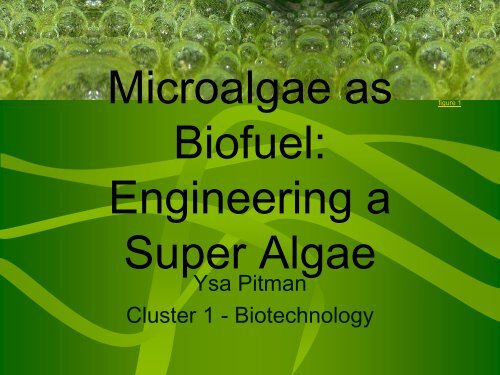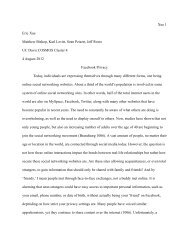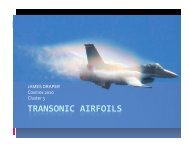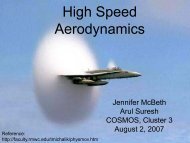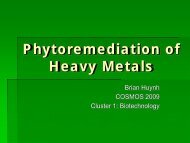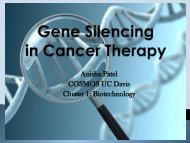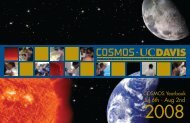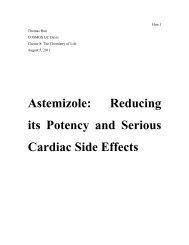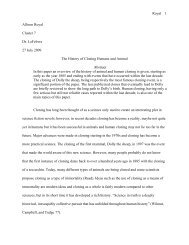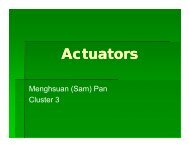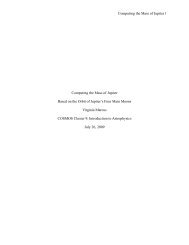Microalgae as Biofuel: Engineering a Super Algae - COSMOS
Microalgae as Biofuel: Engineering a Super Algae - COSMOS
Microalgae as Biofuel: Engineering a Super Algae - COSMOS
You also want an ePaper? Increase the reach of your titles
YUMPU automatically turns print PDFs into web optimized ePapers that Google loves.
<strong>Microalgae</strong> <strong>as</strong>figure 1<strong>Biofuel</strong>:<strong>Engineering</strong> a<strong>Super</strong> <strong>Algae</strong>Ysa PitmanCluster 1 - Biotechnology
What is algae?• Eukaryotic, photosyntheticorganisms• Live near or in bodies ofwater• Can be multicellular(macroalgae) or unicellular(microalgae)• Metabolize carbon,phosphorus and nitrogen• Types of algae– Greenalgae– Diatoms– Blue-green algae(cyanobacteria)– Golden algaefigure 2
Useful components of algae• Alcohols (hydrocarbons) bioethanol– Naturally produced hydrocarbons in algaelimit reproduction and growth• Oils (lipids) biodiesel– <strong>Algae</strong> in nature are lipid-rich– Light and low temperatures are shownto incre<strong>as</strong>e lipid concentration in algae
Why use algae?Compare to terrestrial biofuelcrops:• F<strong>as</strong>ter growth rate• Higher energy yield per unit ofbiom<strong>as</strong>s– 30–100 times more energyper 10,000 square meters• Can be grown on land unfit forfarmingfigure 5• More efficiently mitigatesatmospheric carbon dioxide• Consumes the le<strong>as</strong>t water ofall biofuel crops
Drawbacks to using algaefigure 6• Lower biom<strong>as</strong>s concentrationthan other biofuel cropsfigure 7• High initial cost due tonew equipment andfacilitiesfigure 8• More fertilizer use oceanic algal blooms dead zones
Industrial techniques forgrowing algae:Pond System– Raceway pattern withpaddlewheels providingconstant churning– Less expensive thanalternatives– Open system moresusceptible tocontamination– Takes up more surfaceareafigure 9figure 10
Industrial techniques forgrowing algae:Photo-bioreactors• More expensive due toinfr<strong>as</strong>tructure costs• Higher efficiency and biom<strong>as</strong>sconcentration due to highsurface area to volume ratio• Shorter harvest timefigure 11figure 7• Closed system• Can regulate O2 and CO2levels in the reactor
Chlamydomon<strong>as</strong> reinhardtii• Single-celled green aglae• H<strong>as</strong> two flagella• Can maintain foreign DNA• Is a “model organism” forresearchers– Helps answerfundamental questions,including how cellschange in response tomineral nutrition• Its genome h<strong>as</strong> beensequenced and mappedFigure 13
• Aceytl-CoA is a key component in the citricacid cycle of photosynthesisLiposynthesis in algaeFigure 12• Aceytl-CoA carboxyl<strong>as</strong>e is the first enzymeinvolved in fatty acid synthesis and regulation
Researchable Question:Will upregulating the generesponsible for Aceytl-CoAcarboxyl<strong>as</strong>e synthesis in c.reinhardtii yield an algal strain witha higher lipid content than the wildtype, thereby maximizing efficiency<strong>as</strong> a biodiesel?
Procedure (1): locate acetyl-CoAcarboxyl<strong>as</strong>e gene in c. reinhardtiiFigure 14• Gene name: CHLREDRAFT_133238• Amplify sequence using PCR– Will need engineered restriction enzymesthat cleave on either side of the sequence
Procedure (2): Find transcriptionfactor for ACC<strong>as</strong>e gene usingAffinity Chromatography• Transcription factors are proteinsthat bind to the enhancer or promoterregions of a given gene andoverexpress the gene• Attach PCR product molecules tosolid matrix beads in a column• Pour extract of c. reinhardtii cellsover the beads• The promoter’s protein will bind tothe beads (all other proteins flowthrough column)• W<strong>as</strong>h beads with buffer that rele<strong>as</strong>esproteinsFigure 15
Procedure: Me<strong>as</strong>ure lipidcontent in control and newstrain• Add Nile Red (a fluorescent lipophilic dye) to eachsample• Perform NIR spectroscopy on the samples– NIR = “near infra-red”– NIR spectroscopy is more effective than solventextraction protocol• Needs smaller sample• More rapid process: minutes rather than days• After a period of growth, compare lipid m<strong>as</strong>s in thecontrol strain and the upregulated strain
Expected results• The upregulated strain of c.reinhardtii will have a higher lipidcontent after the growth period thanthe control strain of c. reinhardtii
Bibliography• S. Scott, M. Davey, J. Dennis, I. Horst, C. Howe, D. Lea-Smith, and A.Smith, Biodiesel from algae: challenges and prospects, Current Opinionin Biotechnology 21 (2010), pp. 277-286• A. Demirb<strong>as</strong>, Use of <strong>Algae</strong> <strong>as</strong> biofuel sources, Energy Conversion andManagement 51 (2010), pp. 2738-2749• L. Beer, E. Boyd, J. Peters, M. Posewitz, <strong>Engineering</strong> algae forbiohydrogen and biofuel production, Current Opinion in Biotechnology20 (2009), pp. 264-271• R. Radakovits, R. Jinkerson, A. Darzins, M. Posewitz, Geneticengineering of algae for incre<strong>as</strong>ed biofuel production, Eukaryotic Cell 9(2010), pp. 486-501• J. Rosenberg, G. Oyler, L. Wilkinson, M. Betenbaugh, A green light forengineered algae: redirecting metabolism to fuel a biotechnologyrevolution, Current Opinion in Biotechnology 19 (2008), pp. 430-436• Khozin-Goldberg, Z. Cohen. Unraveling algal lipid metabolism: Recentadvances in gene identification, Biochimie 93 (2011), pp. 91-100.• M. Griffiths, S. Harrison. Lipid productivity <strong>as</strong> a key characteristic forchoosing algal species for biodiesel production, Journal of AppliedPhycology (2008).• L. Laurens, E. Wolfrum, A. Darzins, Predicting Algal LipidConcentrations using NIR Spectroscopy. In <strong>Algae</strong> Industry Magazine.


